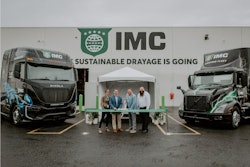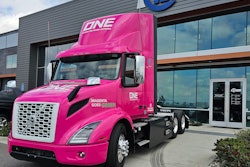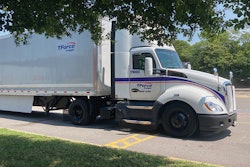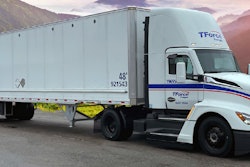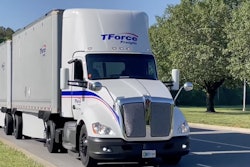 Phase 1 of the plan would establish hubs that would eventually be connected as the network grows.
Phase 1 of the plan would establish hubs that would eventually be connected as the network grows.
The Biden administration Tuesday released its plan to establish a charging and refueling infrastructure network for zero-emission commercial trucks, an initiative that seeks to maximize the impact of charging infrastructure investment by guiding development toward high-volume-priority corridors and existing freight hubs.
The National Zero-Emission Freight Corridor Strategy, developed by the Joint Office of Energy and Transportation and U.S. Department of Energy (DOE), in collaboration with the Department of Transportation (DOT) and the Environmental Protection Agency (EPA), was drafted to meet growing market demands by targeting public investment to amplify private sector momentum, focus utility and regulatory energy planning, align industry activity and improve air quality in local communities heavily impacted by diesel emissions.
[Related: Daimler Truck, Volvo Trucks and Navistar ink battery truck 'PACT']
The strategy is based on a focused buildout around freight and trucking return-to-base depot infrastructure, regional hub-to-hub corridors and national network nodes. Federal Highway Administrator Shailen Bhatt noted that medium- and heavy-duty trucks in the current freight network contribute approximately 23% of greenhouse gas emissions in the U.S. transportation sector.
Commercial trucks represent roughly 10% of all vehicles on the road, yet 75% of heavy truck traffic travel on just 4% of our nation’s roads, said President Biden’s National Climate Advisor Ali Zaidi, adding "investments in zero-emission infrastructure on those high-traffic roads and the hubs they connect will rapidly transform freight transport..."
 To prioritize the buildout of ZE-MHDV infrastructure nationwide, the Strategy evaluates critical deployment factors that target favorable investment areas along the National Highway Freight Network4 (NHFN) and within supporting freight ecosystems. The strategy moves through four progressive phases to promote zero-emission truck adoption from 2024 to 2027, 2027 to 2030, 2030 to 2035, and 2035 to 2040.
To prioritize the buildout of ZE-MHDV infrastructure nationwide, the Strategy evaluates critical deployment factors that target favorable investment areas along the National Highway Freight Network4 (NHFN) and within supporting freight ecosystems. The strategy moves through four progressive phases to promote zero-emission truck adoption from 2024 to 2027, 2027 to 2030, 2030 to 2035, and 2035 to 2040.
David Fialkov, executive vice president of government affairs for NATSO and SIGMA – the trade associations representing truck stops, travel plazas and fuel marketers – applauded the Biden administration for "recognizing the critical link between how freight moves today and the efficient build out of a nationwide network of charging stations for medium and heavy-duty trucks. For this to work, it needs to impose minimal disruption on how businesses operate today," he said. "This plan recognizes that."
The number of publicly available EV chargers nationwide has increased by more than 80% to more than 173,000 since 2020, according to the White House. However, widespread rollout has been elusive as traditional refueling stops have been hesitant to heap cash into a zero emissions chicken (BEVs) or egg (infrastructure buildout) scenario.
"Many challenges exist to electrifying commercial trucks, including electricity generation and access as well as the need for fuel retailers to generate a return on investment," Fialkov said. "Fuel retailers are at the forefront of investments in new refueling technologies and their requisite infrastructure. We have long held that President Biden's goal of establishing a nationwide network of electric vehicle charging stations for all vehicle classes is best achieved by harnessing the existing nationwide network of refueling locations. Directing states to adopt a phased approach that prioritizes investments along key freight corridors can harness the existing nationwide network of refueling locations along the Interstate Highway System and encourage investment in emerging refueling technology."
Deployment factors baked into the plan include corridor segment usage by freight volume; port usage by annual freight tonnage; projected ZE-MHDV volumes; disproportionate environmental and air quality burden from MHDV transportation and non-attainment for criteria air pollutants; states with ZEV deployment-enabling policies; and “on the ground” planning through DOE’s commercial ZEV corridor planning grants.
The National Zero-Emission Freight Corridor Strategy will prioritize, sequence, and accelerate infrastructure along key freight corridors and hubs in four phases.
- Establish priority hubs based on freight volumes (2024-2027)
- Connect hubs along critical freight corridors (2027-2030)
- Expand corridor connections initiating network development (2030-2035)
- Achieve national network by linking regional corridors for ubiquitous access (2035-2040)
Establishing the hubs of zero emission hub and spoke
Executive Director of the North American Council for Freight Efficiency (NACFE) Mike Roeth told Clean Trucking Wednesday morning that sophisticated trucking telematics platforms have helped give granular detail about where trucks move and how long they are there, helping establish where these early zero emission hot spots make the most sense.
"It's not as easy to figure it out as you think. We kind of know where the fright flows are. We kind of know where trucks are domiciled. Without big data, they couldn't have done it," Roeth said. "Ten years ago, they couldn't have done it. Using diesel truck movement, they can figure out where electric truck charging is going to need to be."
Roeth said NACFE agrees with the four-phase strategy laid out by the White House.
"A lot of (Phase 1) is very urban," Roeth said, "places NACFE would say the first power demands are going to be on the utilities... Around airports, sea ports..."
Phase 2 establishes the spokes that connect the hubs as Phases 3 and 4 reach longer haul routes, and "that's where they bring hydrogen into the discussion.,., and much faster charging," Roeth said. "If we're going to do all these zero emission trucks in the timeframe they're talking about, this makes sense for an infrastructure strategy. It's a good roadmap."




